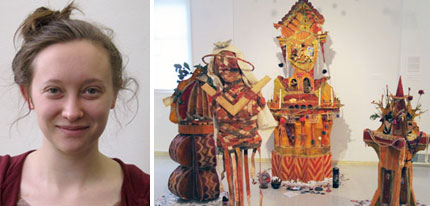 Raye Watts is the 2011 recipient of the annual Library Art Award for her work “Altar I,” which will be on display in the library for one year. A double major in English Literature and Studio Art. Raye grew up in San Diego and admits that she “can neither surf nor develop a satisfactory tan.” She was exposed to creativity, critical thinking, and language at an early age, which she attributes to her “Grateful Dead, bear emblazoned” Montessori teacher. Since moving to Tacoma, Raye has become a contributing member of the student art and craft market and vows to “buy one piece of art a month” as way of engaging with the local creative community.
Raye Watts is the 2011 recipient of the annual Library Art Award for her work “Altar I,” which will be on display in the library for one year. A double major in English Literature and Studio Art. Raye grew up in San Diego and admits that she “can neither surf nor develop a satisfactory tan.” She was exposed to creativity, critical thinking, and language at an early age, which she attributes to her “Grateful Dead, bear emblazoned” Montessori teacher. Since moving to Tacoma, Raye has become a contributing member of the student art and craft market and vows to “buy one piece of art a month” as way of engaging with the local creative community.
Congratulations, Raye!
Artist’s Statement
Though I often feel unfit to purport to be an artist, art is the only endeavor that I will elect to work on until my fingers are bent and throbbing, it feels like my spine has truncated, and my face has gone slack; both obsession and devotion. I use found objects and papier-mâché because they are personal and unassuming— my very relationship with art. The use of repurposed detritus allows me to feel that I am elevating the inane into something visually stimulating. Using inconsequential recycled materials, I am able to relieve my compulsion without the inhibition of technique, expectation, or convention. I am less constricted and self-aware while creating and able to delve more fully and sincerely into the artistic process. I gravitate toward tedious and overwhelming projects because it gives me the sense that I am truly committing myself to art and creating a work of devotion.
compulsion without the inhibition of technique, expectation, or convention. I am less constricted and self-aware while creating and able to delve more fully and sincerely into the artistic process. I gravitate toward tedious and overwhelming projects because it gives me the sense that I am truly committing myself to art and creating a work of devotion.
I wanted to explore a religious theme in my project because I consider art a belief system that indoctrinates devotees with the promise of a purposeful and meaningful existence. Fruit, flowers, candles and photographs, are collected for both the altar and still-life. The personal altar, like a self-portrait, is individual. Both art, and religion have a reciprocal relationship with the individual. Skin tinted, lacerated, and burned, the artist is molded by the artistic process. While art is a means of elucidation and self-expression, it is also torment and relief, instigator and outlet. Art requires regular practice and observation. Art must be fueled and informed; as the artist develops, the art develops. Self-portraiture, like meditation, forces the artist to confront his or her psyche and soul.
The communal studio space is not unlike a religious congregation. Brought together by a common source of personal fulfillment, this group of artists communicates ideas which affirm, develop and challenge the individual’s relationship with art.
